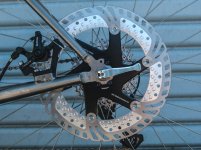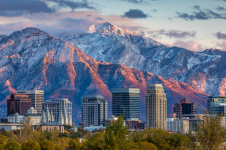I'm on hydraulic discs,180mm front 160mm rear, sintered pads... it is NOT enough for a 10% grade. I'm carrying 80Ah @ 66.6v of battery, 3kw mid drive with a nuvinci CVT rear hub, steel frame weighs 80kg plus rider(60kg) & cargo.
I had a runaway situation yesterday and encountered a small ditch as I steered off the pavement into a driveway. The cargo bike, and cargo, became airborne. For a brief moment I was piloting an aircraft, but I did not fall with style.
I fell over as the bike landed but I stayed on the frame as we slid through the dirt and mud to a stop. I used all my drinking water and some puddles to cool the brakes, they were hissing and steaming as the water hit them.
Bicycle damage: headset bearing seat bent out of round, (fork moves fore and aft under brake load now, steering's a bit wonky too).
Rider damage: 2cm diameter abraision on the left knee, no blood loss.
The Flying Red Bakfiets, the black ebike was in the cargo basket at the time of the crash:
I've not ruled out scrapping this bike and building a lighter long tail, but still, I need better brakes on both bikes.
any suggestions?
I had a runaway situation yesterday and encountered a small ditch as I steered off the pavement into a driveway. The cargo bike, and cargo, became airborne. For a brief moment I was piloting an aircraft, but I did not fall with style.
I fell over as the bike landed but I stayed on the frame as we slid through the dirt and mud to a stop. I used all my drinking water and some puddles to cool the brakes, they were hissing and steaming as the water hit them.
Bicycle damage: headset bearing seat bent out of round, (fork moves fore and aft under brake load now, steering's a bit wonky too).
Rider damage: 2cm diameter abraision on the left knee, no blood loss.
The Flying Red Bakfiets, the black ebike was in the cargo basket at the time of the crash:
I've not ruled out scrapping this bike and building a lighter long tail, but still, I need better brakes on both bikes.
any suggestions?






